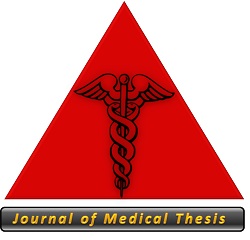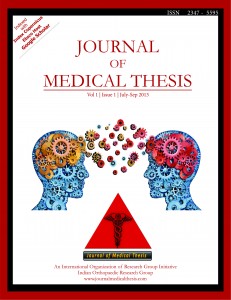Comparison Between Various Modalities of Treatment of Distal End Radius Fractures
Vol 2 | Issue 3 | Sep - Dec 2014 | page:9-11 | Saraogi Akash Ashok, Sonawane Dhiraj V, Chandanwale Ajay, Jagtap Sanjay A, Shah Nadir Z, Bhoyar Rahul P
Author: Saraogi Akash Ashok[1], Sonawane Dhiraj V[1], Chandanwale Ajay[1], Jagtap Sanjay A[1], Shah Nadir Z[1], Bhoyar Rahul P[1]
[1] J.J. Hospital, Byculla, Mumbai-08
Institute at which research was conducted: Grant Government Medical College & Sir J.J. Group Of Hospitals, Byculla, Mumbai-08.
University Affiliation of Thesis:Maharashtra University Of Health Sciences, Nashik.
Year of Acceptance: 2014
Address of Correspondence
Dr. Saraogi Akash Ashok
Assistant Professor, M.S. (Ortho.), J.J. Hospital, Byculla, Mumbai-08.
Email: saraogiakash@gmail.com
Abstract
Background: Management of distal radius fractures has changed significantly since Colle's proclamation in 1814. Our study is intended to find out both conceptual and practical guidance for precision treatment with an expectant favorable result.
Method: 120 patients of distal end radius fractures were treated with Cast immobilization, Augmented External fixation, Volar locking plate fixation, Percutaneous Pinning and plaster immobilization. A.O. classification was used. Functional outcomes were assessed using “Demerit point rating system” of Gartland & Werley (modified).
Results: The most common fracture type was A2. 63.3% excellent results were obtained in the plating group as compared to 46.7% in the cast group and the k-wiring group. 63 patients had excellent result outcome, 31 patients had good, 23 patients had fair and 3 patients had poor result outcome.
Conclusion: Functional outcome depends upon patient's age, fracture anatomy, displacement, reducibility, stability and articular incongruity of fractures. They are related more to the quality of anatomical reduction than to the method of immobilization. Volar locking plating is a safe and effective treatment for unstable fractures. Specially locking implants provide advantages in fractures with metaphyseal comminuted zones (A3 and C2 fractures).
Keywords: Distal Radius Fracture, Functional Outcome, Colle's Fracture, Volar Plating.
Thesis Question: Which is best modality of treatment of Distal End Radius Fracture?
Thesis Answer: Depends upon patient's age, fracture anatomy, displacement, reducibility, stability and articular incongruity of fractures, however, volar locking plating is a safe and effective treatment for unstable fractures.
| THESIS SUMMARY |
Introduction
The management of distal radius fractures has changed significantly since Colle's proclamation in 1814. Distal radius fractures have an approximate incidence of 1:10,000 people and represent 16% of skeletal and 74% of forearm fractures. They are more prevalent among females. The most common trauma mechanism is falling over the outstretched hand. The desire for anatomical restoration of the distal radial joint is the rationale for operative treatment. The extent of displacement, the degree of articular disruption, the stability and the reducibility of each fracture, as well as any concurrent injury to adjacent nerves, tendons or carpal structures must be assessed carefully in the planning of logical treatment. More than 1000 peer-reviewed studies have been published on the subject, yet there is no consensus on which treatment is superior or firm guidelines for treatment decisions. Distal End Radius fracture is frequently comminuted & this is responsible for slipping of the reduction, which is a rather common late feature. It is observed, therefore, that this fracture possesses little or no stability following closed reduction & it goes on for gradual collapse.
Aims & Objectives
1. To study fracture patterns of distal radius fractures & compare the results of different methods of treatment of fracture distal end radius.
2. To find out relationship between articular incongruity or perfect anatomical restoration of distal radius fractures and functional results & find out basis for selecting the method of treatment.
Materials and Methods
Study Design:
In this study 120 patients were treated for fractures of distal end radius in a tertiary care centre in a metropolitan city.
Inclusion criteria:
· Age - 15 to 65 years.
· The patient presented within two weeks of the injury.
Exclusion criteria:-
· Immature skeleton
· Congenital Deformity
· Compound cases
Study Period:
May 2011 to Oct 2013
Method Of Study:
After the approval from Institutional Ethics Committee, 120 patients of distal end radius fractures were enrolled in the study after obtaining informed written consent. A.O. classification was used for classification of fractures.
Techniques used:
1. Conservative — Cast immobilization
2. Operative —
a) External fixation
b) Internal Fixation - Volar locking plate fixation.
c) Percutaneous Pinning and plaster immobilization.
Intervention was done within a week after presentation.
Scoring System
Functional outcomes were assessed at final follow up visit using “Demerit point rating system” of Gartland & Werley {modified by Sarmiento et al (1975) & further modified by Lucas & Sachtjen(1981)} [2]
Results
The most common fracture type treated by Casting was A2 type, by Augmented external fixation was C2 type & by K-wiring was A2 type. The most common fracture type in this study was A2 followed by C2 & A3. The mean age of the study participants was 37 years. Age range was 18-65 years. Males were more commonly affected with M:F ratio of 3.3 : 1. Non-dominant side was more commonly involved than the dominant side. The mean volar tilt in the augmented external fixation group was -0.30 degrees whereas the median of the same group is 4 degrees. The mean for plating group is 3.43 degrees. The mean radial angle is highest in the plating group i.e. 19.13 degrees whereas it is lowest in K-wiring group i.e. 16.33 degrees. Mean value of Modified Gartland & Werley Total Demerit Score was 4.23 for the plating group whereas it was 6.37 for the K-wiring group. One patient developed pin tract infection in the k-wire group whereas 2 patients developed pin tract infection in the exernal fixator group. 2 patients in the Volar LCP group developed superficial infection, which resolved with antibiotics and dressings. 63.3% excellent results were obtained in the plating group as compared to 46.7% in the cast group and the k-wiring group. Overall, 63 patients had excellent result outcome, 31 patients had good, 23 patients had fair and 3 patients had poor result outcome.
Discussion
The demerit point system was chosen over other functional scoring systems as it takes into consideration not only objective evaluation but also the subjective parameters and complications associated with treatment like poor finqer function, nerve complication and pain due to arthritis. The cast immobilization was done in non-articular undisplaced, non-articular displaced reducible and stable and articular displaced reducible and stable fractures (A.O. type- A2, B1 & C1 in this study). It has given Excellent to Good results in 80% cases treated conservatively. The results were better than in a series presented by Gartland and Werley (1951) (Excellent to Good results in 68.3%) due to proper selection of treatment in present series whereas in other series cast were given in all cases.
Indications for operative management were:
Displaced intra-articular fractures with (either of them):
1.Post reduction articular step of > 2 mm,
2.Post reduction radial shortening of > 3 mm,
3.Post reduction > 15 degrees of saggital plane angulation (as measured from the anatomical volar tilted position).
The type of operative treatment was selected was according to the fracture anatomy.
Augmented External fixator with ligamentotaxis was used in non-articular irreducible displaced fractures; articular, displaced fractures which were reducible but unstable; irreducible and complex fractures (A.O.Type- A3, C2, C3 in this study). Excellent to Good results were obtained in 76.6% cases, Fair in 20% eases. The results were comparable to other series (Good 85%, Fair 12% - Cooney WP et al 1979).
Trans-fixation with k-wire and immobilization in cast was done for non-articular displaced reducible but unstable fracture and articular displaced reducible and stable fractures (A.O.Type – A2, A3, B1, C1, C2, C3 in this study). In the present series, results were Excellent to good in 70%, fair in 23.3% and poor in 6.7% cases. In a series presented by Suman R.K. (1983) Excellent to Good results were in 81.1% and Fair to Poor results in 18.9% cases.
Internal fixation with volar LCP system was used in 30 patients (A.O.Type- A2, A3, B2, B3, C1, C2, C3]. In the present series, results were excellent in 63.3%, good in 23.3%, fair in 13.3% as compared to study by Murakami K. et al who treated 24 patients (Chiba, Japan) showed 83.3% excellent results & 16.7% good results with volar LCP. An advantage of volar plating technique is the comfort that it provides to patient in initiating early finger & wrist motion. Despite, our use of an early motion rehabilitation protocol, the distal end radius fracture reduction was maintained at the follow- up periods. Early rehabilitation had the additional advantage of enabling the patient to regain independence in daily activities rather quickly. In a present series, 6.7% patients developed arthritis, in whom, 80% had articular incongruity of 1-2 mm. In a retrospective study by Knirk J.L.et al (1986), it was concluded found that accurate articular restoration was the most critical factor in achieving a successful result. While interpreting the results it may be said that articular incongruity, loss of radial length and angular deviation were the most significant influences in that order, on the development of post-traumatic arthritis and overall end result
Conclusion
The treatment goal for fractures of the distal end of the radius is fully functional recovery of the wrist and prerequisites are restoration of the anatomy and early mobilization. Extra-articular fractures give better results than intra-articular fractures. Functional outcome depends upon patient's age, fracture anatomy, displacement, reducibility, stability and articular incongruity of fractures. It has also been shown that functional results are related more to the quality of anatomical reduction than to the method of immobilization. Volar locking compression plating is a safe and effective treatment for unstable fractures of the distal radius. It can also stabilize dorsally unstable distal radius fractures with least complications. Specially locking implants provide advantages in the treatment of distal radius fractures with metaphyseal comminuted zones (A3 and C2 fractures).
Bibliography
1. Belloti JC, Tamaoki MJ, Franciozi CE, Santos JB, Balbachevsky D, Chap Chap E, Albertoni WM, Faloppa F. Are distal radius fracture classifications reproducible? Intra and interobserver agreement. Sao Paulo Med J. 2008 May 1;126(3):180-5 PubMed PMID: 18711658.
2. Vaughan PA, Lui SM, Harrington IJ, Maistrelli GL. Treatment of unstable fractures of the distal radius by external fixation. J Bone Joint Surg Br. 1985 May;67(3):385-9. PubMed PMID: 3997946.
3. Gartland JJ Jr, Werley CW. Evaluation of healed Colles' fractures. J Bone Joint Surg Am. 1951 Oct;33-A(4):895-907. PubMed PMID: 14880544.
4. Phadnis J, Trompeter A, Gallagher K, Bradshaw L, Elliott DS, Newman KJ. Mid-term functional outcome after the internal fixation of distal radius fractures. J Orthop Surg Res. 2012 Jan 26;7:4. doi: 10.1186/1749-799X-7-4. PubMed PMID: 22280557; PubMed Central PMCID: PMC3398340.
5. Cooney WP 3rd, Linscheid RL, Dobyns JH. External pin fixation for unstable Colles' fractures. J Bone Joint Surg Am. 1979 Sep;61(6A):840-5. PubMed PMID:479230.
6. Suman RK. Unstable fractures of the distal end of the radius (transfixion pins and a cast). Injury. 1983 Nov;15(3):206-11. PubMed PMID: 6642635.
7. Murakami K, Abe Y, Takahashi K. Surgical treatment of unstable distal radius fractures with volar locking plates. J Orthop Sci. 2007 Mar;12(2):134-40. Epub 2007 Mar 30. PubMed PMID: 17393268.
8. Knirk JL, Jupiter JB. Intra-articular fractures of the distal end of the radius in young adults. J Bone Joint Surg Am. 1986 Jun;68(5):647-59. PubMed PMID: 3722221.
| How to Cite this Article: Saraogi A A, Sonawane D V, Chandanwale A, Jagtap S A, Shah N Z, Bhoyar R P. Comparison Between Various Modalities of Treatment of Distal End Radius Fractures. Journal Medical Thesis 2014 Sep-Dec ; 2(3):9-11 |
Download Full Text PDF | Download Full Thesis




